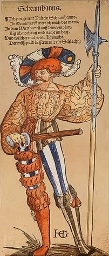ARMS & AMOUR OF THE LANDSKNECHTS
THE BIRTH OF PIKE & SHOT

CLOTHING - Soon after the landsknechts were created, the emperor Maximilian exempted them from the imperial sumptuary laws that forbade the lower social classes from wearing brightly coloured clothing. The landsknechts were quick to adopt the expensive, impractical garments that were the badge of nobility and they soon took the fashion for slashed doublets, outlandish breeches and tightly fitting hose to extremes.
The contrasting colours of their voluminous puffed sleeves, enormous codpieces and out-sized plumed hats did more than advertise the landsknechts' status as favoured citizens of the empire. Their deliberately shocking clothing was designed to horrify and outrage the civilian population in much the same way that 1970s punk rockers adopted safety pins and ripped jeans for their uniform.
The landsknechts' sartorial version of 'shock and awe' certainly succeeded and their preferred pastimes of drinking, brawling and whoring only enhanced their reputation for effective, bloody violence.
POLEARMS - In the massed ranks of the pike square, the primary weapons were either the 18 foot pike or the seven foot halberd. With ash shafts and iron blades, both weapons were cheap, easy to use and ideally suited to the mercenary armies of Swiss reisläufer and their landsknecht imitators.
The pike was based on the long spears used by the ancient Macedonian phalanxes of Alexander the Great but the medieval halberd's combined axe blade, spear and hook (or spike) was inspired by the agricultural implements with which the Swiss and German peasantry were familiar.
Despite its humble origins, the halberd was a truly lethal weapon, which could slice through human bodies with remarkable ease, and both Charles the Bold Duke of Burgundy and Richard III king of England were killed by lowly foot soldiers wielding halberds.


SWORDS - In addition to the halberd, some more experienced landsknechts favoured the six foot zweihänder (double handed) sword. These imperious weapons were the usually preserve of the doppelsöldner (double-pay men) who'd rush forward from the ranks of their own pike square to lop the heads off the opposing army's pikes and pikemen.
As a secondary weapon all landsknechts carried short katzbalger (cat skinner) swords for use at close quarters. The katzbalger's double edged, round tipped blade was designed for cutting and slashing whilst the hilt's distinctive 'S' shaped quillons (crossguard) were used to block and parry counter attacks. Even when not on campaign, a landsknecht always hung his katzbalger from his belt unsheathed so it was ready for instant use in a brawl or to defend himself against bandits.
FIREPOWER - To begin with, most landsknecht armies included crossbowmen and archers but towards the end of the 15th Century these antiquated weapons began to be replaced by firearms. Landsknechts quickly became highly skilled with both the hand held arquebus, a forerunner of the musket, and heavy artillery pieces such as sakers and culverins. The plate armour worn by noble knights offered no protection against a lead ball fired from a humble arquebus and the large siege guns could reduce a city's medieval walls to rubble in just a few hours.
Gunpowder had been known in the west for centuries (in 1346 Edward III had used cannon at the Battle of Crécy) but German landsknechts were the first to use firearms in significant numbers. The imperial army's rout of a much larger force of French knights at Pavia [1525] was almost entirely due to the landsknechts' proficiency with handguns and this famous victory marked the beginning of modern warfare.
